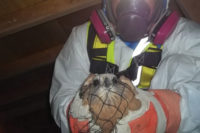Bats can compress their bodies to squeeze through a hole the size of a quarter. Being that older homes often lack retrofitting to assure no gaps are accessible on the outside of the structure, this type of animal infestation – and its subsequent restoration – can be very common.
Headquartered in Orlando, FL, Baxter Restoration frequently has the opportunity to troubleshoot this unique type of job due to the bat population of the state. Florida is home to 13 different protected bat species – and when the creatures find their way into homes or buildings, it can be a delicate and time-consuming endeavor to remove them. In fact, Floridians are actually encouraged to provide alternate habitats, such as putting up bat boxes on their residence, to deter bats from seeking shelter in their homes and to combat mosquitoes.
Recently, Baxter Restoration was called to a residence in Sanford, FL where there was a significant bat infestation. It was so severe that the ceilings and walls had begun to bow from the sheer number of bats that had squeezed into the spaces between.
“The animal removal company told us that 3,000 bats had been living in an 18 square-foot area,” says Dave Baxter, Owner, Baxter Restoration. “Add in all their poop (guano) and soon the walls just can’t hold it in.”
The homeowners noticed the bats entering and leaving the house through a very small void in the siding. They contacted several professionals to get help before finally contacting their insurance carrier, Prepared Insurance Company of Tampa, FL and US Forensics.
Allstar Animal Removal was contacted to install a “bat valve” at the point of entry. Simply put, a bat valve is a construct that allows the bats to exit the residence but prevents them from reentering. It could take as long as a week for all the bats to leave the building, then infested areas can be properly sealed to prevent return infestation. But after they’ve all exited, there’s the issue of cleaning up the mess left behind…
This type of clean-up job falls under the biohazard category due to the threat to humans resulting from the toxic guano in a bat infestation. Rabies, bat bugs and histoplasmosis are all ailments that can affect the residents and the restoration crew. Histoplasmosis infection, specifically, occurs from the inhalation of the fungi spores from the guano, which can complicate the cleanup procedure. Needless to say that a thorough cleaning is necessary in these situations to assure that all biological hazards are eliminated. If a job is not completed to spec, lingering health hazards can continue to affect residences long after the restoration is complete.
To stay safe, the crew wore full protective suits, respirators and gloves for the job. The situation was grim. The interior of both the master bathroom and bedroom were affected due to the infestation. It was necessary to remove all contents of the bathroom including rugs, toiletries and personal care items, clothing items, medicines, bathmats, nick-knacks, and furniture. The master bedroom’s contents were then sealed in plastic.
Double containment barriers were installed at both entrances to the bathroom and bedroom as well as the closet entrance. A small-scale HEPA filtration unit was placed on recirculation mode. Some bathroom fixtures needed to be removed for cleaning and re-installation, including the commode and sink.
The carcasses from bats that had died while inhabiting the residence were removed using tongs and double bagged. All in all, 51 square feet of both the east and south ends of the interior wall and insulation needed to be removed. The insulation was removed by hand and bagged. Additionally 23 square feet of the ceiling was removed.
All surfaces were treated with a Sporicidin antimicrobial product using a hand-pumped sprayer. Wood studs, exterior walls, wall studs, rafters and roof deck boards were disinfected by hand scrubbing with brushes. An additional Sporicidin treatment was applied and this was then followed by a 10% Sporicidin dilute solution with water, which was used to wipe down all bathroom surfaces. All waste and rags were double-bagged and disposed of according to local requirements.
The exterior paneling of the residence was loose and had gaps, so power or pressure washing was not an option. The plants and vegetation needed to be protected before exterior clean-up would commence. Plastic sheeting was used to shield them from any chemical product used. Exterior surfaces were then sprayed. All surfaces were then brush-scrubbed and washed clean.
Dealing with a biohazard cleanup can be tumultuous at best. The addition of the danger to the crew makes it absolutely imperative that all safety guidelines are adhered to with the use of proper protective equipment and respirators. It can, however, be very gratifying to know that clients are able to return to their residence confident that they are free of hazard and the bats are back in their natural habitat.





Report Abusive Comment